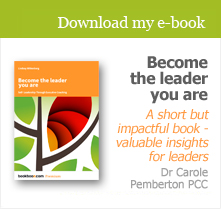Relationships: the leader’s secret weapon

The pressure on leaders
I’m working with two leaders in very different sectors whose organisations – and whose roles – have been significantly affected by the downturn. Income is more difficult to generate, budgets have been slashed, and everyone in their organisations is feeling the pressure on top of the threat of redundancy (a threat already realised for some people in both organisations). They need to get more from less – from fewer team members, smaller budgets, more cautious customers, and stiffer competition. The leadership tasks to be fulfilled are urgent and important. They demand clearer thinking, tough decisions, and well-based judgments.
Distracted by a task focus
Amid such stress and pressure, leaders are sometimes tempted to focus on the task and the process for fulfilling that task. One of my clients has felt overwhelmed by the enormity of the task, distracted by the fear of failure, and has been desensitised to the needs and the motivations of their people. The other has needed to deal with a powerful senior report who regularly goes off-piste and fails to deliver. It seemed easier and more obvious to both of them to engage with the clarity of the task than the mysteries of how people feel and the apparent cost of spending time in conversation. But the results didn’t appear and both of them subsequently realised that they didn’t take enough account of the drivers that maximise their teams’ motivation and engagement to get the task done.
A transactional or task-based approach may bring short-term results. But it fails to stimulate the energy and the discretionary effort which lead to people taking initiative, being effective and efficient, and feeling loyal and committed and aligned within their teams.
Relationship: the secret weapon
The secret weapon is the relationship between the leader and his or her team members. These clients and others have discovered this after wondering why, with the highest quality tactical plans in place, results are elusive. And elusive results are a luxury they can’t afford. Both of them turned those results around when they started to recognise their people for who they were. They made this recognition explicit by listening and by articulating what they valued others for. They recognised strengths and re-designed roles around this recognition. The quality of their relationships improved significantly and performance levels improved too.
Listening
The very first step is for the leader to actually care about his or her people and to acknowledge that others may have something valuable to add to the pot. If they care and acknowledge in this way, the chances are they’ll listen better – and listening is essential to make the connections that ignite people’s energy and enthusiasm, and release what they’re really capable of because they feel valued enough to be worth listening to.
In ‘The Discipline of Listening’, a Harvard Business Review blog post, Ram Charan refers to the importance of understanding each person’s frame of reference, i.e. where they are coming from. Without that the leader will find it challenging to bring them on board: how can they persuade or recruit support if they’re effectively speaking a different language and if they haven’t taken the trouble to understand what preoccupies, concerns and drives every member of their team? Understanding these factors is a short cut to not only getting the task at hand done but also creating the goodwill that will fuel the fulfilment of future tasks.
Communication and openness
Other key components of the relationship have to include clear, honest, open communication, and the leader’s openness about themselves: the leader who shows him- or herself to be human, and who owns up to their mistakes, and is clear and consistent about their values can be a compelling leader.
Trust
Arguably, the most important outcome of a healthy relationship is trust. A team that trusts its leader (and whom the leader trusts, of course) will follow them to the ends of the earth, will bring all sorts of discretionary effort, and will release the leader from a host of smaller tasks to focus on where they bring most value. See another of my blogs on trust here.
Strategy via relationships
You can create the most well-crafted strategy you like: only with healthy relationships in place will it have impact and stickability for the medium- and long-term.
Photo by Benson Kua via Compfight



What an excellent summary, Lindsay, of what I always think of as one of the core leadership qualities (perhaps the most important) and a huge differentiator for many. As you say, a well formed strategy is critical for progress BUT without winning the hearts and minds of others, then execution is compromised (and often “big time”). I can think of a number of leaders I’ve worked with in the past who invested in relationships and I say this investment pay out in large measures! (and sadly vice versa too!). As you’ll know, exit surveys frequently show that good people “join companies” (projects) and “leave bosses” (leaders) – another indicator of the importance of the “secret weapon”
I think that part of what’s got in the way of recognising the power of relationships is the drive to quantify return on investment for every action and initiative. The power of relationships is holistic and viral: you can’t always compute the result directly or rapidly. However it shows up in retention figures (people don’t leave organisations they’re happy in nearly as readily as they leave when their bosses are difficult, as you say, Frank), in engagement levels and in innovation and creativity. It also translates itself into hard business results even though it may be hard to trace.
Good point Lindsay, many leaders are so busy with tasks they don’t even think about their relationships with staff. I think ‘build relationships with staff’ should be a task in itself, placed high on a leader’s daily ‘to do’ list. You only have to watch an episode of Back To The Floor or Undercover Boss to see how life-changing and business-changing it can be for a leader to really get to know the people working for them.
Absolutely. In my experience a leader who really gets to know their staff – especially if, in the process, they convey that they care about them too – already has a head start over the uniquely task-focused leader. With every member of staff on your payroll you get a free heart and a free brain: when both hearts and brains are engaged in fulfilling the purpose of the organisation, you’re so much more likely to get the outcomes you want – and more. One of my clients, whose style had been task-focused before his coaching began, who was struggling to get the best out of his team, and who had learnt how to build relationships, said at the end of his programme that he hadn’t realised he could inspire people as much as he was now doing. What’s that worth on the balance sheet, I wonder….